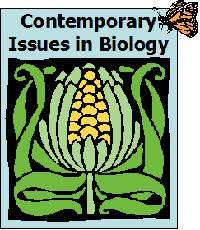
Week 15, Chapter 12 -- Digging Deeper Sample Answer
Course home | Weekly schedule | Announcements | Instructor Info | Desire2Learn | MasteringBiology® | Honor Code | FAQs | HELP!
 |
Week 15, Chapter 12 -- Digging Deeper Sample AnswerCourse home | Weekly schedule | Announcements | Instructor Info | Desire2Learn | MasteringBiology® | Honor Code | FAQs | HELP! |
[Note that these articles are older than those you are allowed to use for this assignment]
Article 1 Summary: The first article I chose was this one:
http://news.bbc.co.uk/1/hi/sci/tech/3220557.stm
It is entitled “Fossil hints at primate origins” and dated 28 October,
2003. It describes the discovery of a 45-million-year-old ankle bone in Burma.
The bone is not human, because modern humans are thought to have originated
only about 2 million years ago. Rather, it may represent an ancestor of all
anthropoids, which are primates like apes and monkeys. Since Burma is near India,
this fossil ties anthropoids to Asia. The article goes on to say that if this
interpretation is correct, the primates would have moved to Africa before humans
evolved and spread out worldwide.
Article 1 Relevance: This article is relevant to the evolutionary history of primates in general, not just humans. So it doesn’t really answer any specific questions about human evolution. Instead, it helps us understand how primates came to Africa in the first place, tens of millions of years before humans evolved.
Article 2 Summary: The second article I chose was this one:
http://www.brightsurf.com/news/feb_03/EDU_news_022103_b.html
Its title is “New age for Mungo Man, new human history,” and it
is dated Feb. 21, 2003.
This article explains that a research team has finally settled the age of a
couple of fossils found in the late 1960s and early 1970s near Lake Mungo in
Australia. “Mungo Lady” and “Mungo Man” are the oldest
human fossils ever found in Australia. Their newly established age is about
40,000 years, which is 22,000 years younger than researchers originally thought
when the fossil’s age was first estimated in 1999. The age of 40,000 years
came from the combined estimates of four different labs using a variety of dating
techniques.
Article 2 Relevance: The article is relevant to the debate over how and when humans left Africa and arrived in Australia. The original, older date would have supported the multiregional hypothesis; the younger date is more consistent with the “out of Africa” hypothesis. It also indirectly bears on the question of when humans developed certain cultural traditions. For example, Mungo Lady’s skeleton was charred, apparently after cremation. Stone tools found near Lake Mungo date to 50,000 years, so these results show that within the next 10,000 years, humans in Australia had developed ritual burial.
Note: I also consulted this website for background on Mungo Man: http://www.hominids.com/donsmaps/mungo.html
Personal reflection: One thing that’s hard for me to understand is how paleontologists identify extinct species based on just one fossilized bone. This is not a problem with the Mungo fossils, because they are complete skeletons. But the ankle bone in the first article is a one-bone find. Obviously, paleontologists know a lot more than I do about the characteristics of specific bones, but it’s amazing to me just know much they know. Luckily, many of the fossils relevant to primate and human evolution are much more complete.
[473 words]
[Back to Digging Deeper assignment]
[Sample assignment by Mariëlle Hoefnagels]